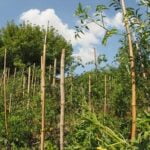When it comes to growing our own food, ensuring its safety is of utmost importance. That’s why using safe materials in vegetable gardens is a topic of great debate among gardeners and experts alike. One material that has sparked controversy is treated wood. While it offers durability and protection against decay, concerns about the potential risks associated with treated wood have raised questions about its suitability for use in vegetable gardens.
The use of treated wood in vegetable gardens raises concerns due to the chemicals used in the treatment process. Treated wood refers to lumber that has been infused with preservatives to protect it from insect damage, rot, and decay. These preservatives typically contain chemical compounds like arsenic, copper, chromium, and zinc. While these compounds are effective at extending the life span of wood, there is a possibility that they can leach into the soil over time.
This leaching of potentially harmful chemicals into the soil is troubling because vegetables grown in contaminated soil may absorb these substances. This raises concerns about the potential health risks associated with consuming crops grown in treated wood beds or containers. Additionally, the impact on soil composition and overall ecosystem health cannot be overlooked when considering the use of treated wood in vegetable gardens.
Understanding Treated Wood and Its Components
In order to make an informed decision about whether or not to use treated wood in vegetable gardens, it is crucial to have a clear understanding of what exactly treated wood is and the components involved in its treatment process.
Treated wood, also known as pressure-treated wood, is a type of lumber that has been infused with chemical preservatives to protect it from decay, insect damage, and fungal growth. The treatment process involves placing the wood in a pressure vessel and forcing the preservative chemicals deep into the cellular structure of the wood. This ensures that the chemicals penetrate evenly throughout the entire piece of lumber, providing long-lasting protection.
The most common chemicals used in treating wood include chromated copper arsenate (CCA), alkaline copper quaternary (ACQ), and copper azole (CA). Each of these chemicals has unique properties and efficacy against different types of decay fungi and insects. CCA was widely used in the past but has since been phased out for residential uses due to concerns about its potential toxicity. ACQ and CA have become more popular alternatives.
The purpose of treating wood is to extend its lifespan when used outdoors or in contact with soil. By protecting the wood from rotting, insects, and other forms of degradation, treated wood can last longer than untreated wood. This makes it an attractive option for many gardeners who want their raised beds or structures made from wood to withstand outdoor conditions.
It is important to note that while treated wood offers durability benefits, there are potential risks associated with using it in vegetable gardens. The next section will delve into these risks and discuss why caution should be exercised when considering treated wood as a material choice for growing food crops.
Potential Risks of Using Treated Wood in Vegetable Gardens
Potential Leaching of Harmful Chemicals into Soil
One of the main concerns surrounding the use of treated wood in vegetable gardens is the potential leaching of harmful chemicals into the soil. Treated wood is infused with various chemicals to protect it from decay, insects, and fungi. However, these chemicals can slowly release into the surrounding environment, including the soil.
The most common chemicals used in treating wood include copper, arsenic, and chromium. These substances have been found to be toxic to humans and wildlife when present in high concentrations. The risk of leaching depends on several factors, such as the type of treatment used, climate conditions, and the age of the treated wood.
To minimize this risk, it is recommended to choose low-toxicity treated wood options that have been certified as safe for use in vegetable gardens. Additionally, creating a barrier between the treated wood and soil can also help prevent direct contact and reduce the potential for chemical leaching. This can be done by lining raised beds or using a protective layer such as plastic sheeting.
Potential Risks to Human Health from Ingesting Crops Grown in Treated Wood
Another concern associated with using treated wood in vegetable gardens is the potential risks to human health from ingesting crops grown in contact with or near treated wood. If harmful chemicals are present in the soil due to leaching from treated wood, they can be absorbed by plants growing nearby or directly into edible crops.
Consuming vegetables that have accumulated toxic substances from treated wood may pose health risks over time. Heavy metals like arsenic and chromium are known to be carcinogenic and neurotoxic at high levels. Therefore, it is important to take preventive measures when considering using treated wood in vegetable gardens.
To minimize this risk, it is advisable to avoid planting edible crops directly against or above treated wood surfaces. Instead, create a buffer zone by planting non-edible plants in between or consider using alternative materials for constructing vegetable beds. Regularly testing the soil for chemical contaminants can also help ensure the safety of crops grown in proximity to treated wood.
Impact of Treated Wood on Soil Composition and Ecosystem Health
Using treated wood in vegetable gardens can also have an impact on soil composition and overall ecosystem health. The chemicals used in treating wood can alter the pH levels and nutrient availability in the soil, potentially affecting plant growth and productivity. Additionally, certain organisms such as earthworms and beneficial bacteria may be negatively impacted by the presence of these chemicals.
To mitigate these potential impacts, it is essential to monitor soil health regularly when using treated wood. Conducting soil tests to assess nutrient levels and pH balance can help identify any imbalances or deficiencies caused by the presence of treated wood. Incorporating organic matter, such as compost or mulch, into the soil can also help improve its overall fertility and support a healthy ecosystem.
By understanding these potential risks associated with using treated wood in vegetable gardens, gardeners can make informed decisions about whether to incorporate this material into their gardening practices. It is crucial to prioritize the well-being of both ourselves and the environment when deciding which materials to use in growing our own food.
Factors to Consider When Deciding to Use Treated Wood
Varying Levels of Toxicity
When considering the use of treated wood in vegetable gardens, it is essential to understand that not all treated woods are created equal. Different types of treated wood may contain varying levels of toxicity depending on the chemicals used in the treatment process. For example, older treatments such as chromated copper arsenate (CCA) have been phased out due to their high arsenic content, which poses significant health risks.
However, newer alternatives such as alkaline copper quat (ACQ) and copper azole have lower toxicity levels and are considered safer for use in vegetable gardens. It is crucial to research and choose a treated wood option that has low-toxicity levels to minimize potential harm.
Lifespan of Treated Wood
Another important factor to consider when deciding to use treated wood in your vegetable garden is the expected lifespan of the material. Treated wood is designed to be durable and resistant to decay, making it an attractive choice for long-term projects like raised beds or fences.
However, the lifespan of treated wood can vary depending on factors such as exposure to moisture, sunlight, and soil conditions. It is essential to assess the longevity of the treated wood and determine if it will meet your needs in terms of durability and sustainability.
Handling, Maintenance, and Disposal
Proper handling, maintenance, and disposal of treated wood are key considerations for minimizing risks associated with its use in vegetable gardens. When working with treated wood, it is crucial to follow safety precautions such as wearing gloves, a mask, and avoiding sanding or burning the material. Regular maintenance should also be conducted to ensure the integrity of the wood’s protective coating over time.
Moreover, when disposing of treated wood at the end of its lifespan, it should be disposed of properly according to local regulations rather than being burned or thrown into landfills where harmful chemicals can leach into the environment. By following these best practices, gardeners can minimize potential risks associated with treated wood in their vegetable gardens.
Alternatives to Treated Wood for Vegetable Gardens
When it comes to using safe and non-toxic materials in vegetable gardens, there are several alternatives to treated wood that gardeners can consider. One popular option is composite lumber, which is made from a combination of recycled plastics and wood fibers. This material offers many benefits such as durability, resistance to rot and pests, and a long lifespan.
Composite lumber is also environmentally friendly as it reduces the need for new trees to be cut down. Additionally, it does not release any harmful chemicals into the soil like treated wood might. Another advantage of using composite lumber is that it can be easily cleaned with soap and water, making maintenance a breeze.
Another alternative to treated wood is cedar, which naturally resists decay and insect damage. Cedar has been used for centuries in outdoor projects because of its durability and natural beauty. It also contains natural oils that repel insects and fungi, reducing the need for chemical treatments.
However, it’s important to note that both composite lumber and cedar come with their own set of considerations. Composite lumber can be more expensive than treated wood, while cedar may have a higher upfront cost but requires little maintenance over time. Gardeners should carefully evaluate their budget, desired lifespan of the material, as well as their environmental concerns before making a decision.
| Material | Durability | Pest Resistance | Maintenance | Environmental Impact |
|---|---|---|---|---|
| Composite Lumber | High | High | Low (Requires cleaning with soap/water) | Eco-friendly (Recycled materials) |
| Cedar | High | High | Low (Minimal maintenance) | Eco-friendly (Naturally resistant, sustainable source) |
Ultimately, the choice of alternative material comes down to personal preferences and specific garden needs. It’s crucial for gardeners to weigh the potential risks associated with treated wood against the benefits offered by these alternatives. By making an informed decision, gardeners can create a safe and sustainable environment for their vegetable gardens.
Best Practices for Using Treated Wood in Vegetable Gardens
When it comes to using treated wood in vegetable gardens, following best practices is crucial to minimize potential risks and ensure the health of both plants and humans. By taking the necessary precautions and adhering to guidelines, gardeners can safely utilize treated wood while maintaining a thriving and sustainable garden.
- Select low-toxicity treated wood options: Not all treated wood is created equal, and some types contain higher levels of toxic chemicals than others. Choose wood that has been treated with safer alternatives such as copper-based treatments or ACQ (Alkaline Copper Quaternary). Avoid using older types of treated wood that may contain hazardous chemicals like arsenic or chromium.
- Prepare the wood properly: Before using treated wood in a vegetable garden, it is important to prepare it correctly. Start by sanding down any rough surfaces to reduce the risk of splinters and create a smoother finish. Then, apply a water-resistant sealant or stain to help prevent any leaching of chemicals into the soil.
- Create a barrier between the soil and treated wood: To further minimize the risk of chemical leaching, consider creating a physical barrier between the soil and the treated wood. This can be done by lining the interior sides of raised beds with heavy-duty plastic sheeting or landscape fabric.
- Practice good hygiene: It is essential to practice good hygiene when working with treated wood in vegetable gardens. Always wear gloves when handling treated wood to avoid direct contact with your skin. After working with it, thoroughly wash your hands with soap and water before touching anything else.
- Monitor plant health: Regularly monitor the health of your plants when using treated wood in your vegetable garden. Look out for any signs of stress or damage that could potentially be linked to chemicals leaching from the wood. If you notice any issues, consider switching to alternative materials or adjusting your gardening practices accordingly.
By following these best practices, gardeners can reduce the potential risks associated with using treated wood in vegetable gardens. Prioritizing safety and sustainability will ensure a healthy and thriving garden while also protecting the soil, plants, and human health. Remember to always consult with local experts or extension services for specific recommendations based on your region’s regulations and conditions.
| Best Practices for Using Treated Wood in Vegetable Gardens |
|---|
| – Select low-toxicity treated wood options |
| – Prepare the wood properly |
| – Create a barrier between the soil and treated wood |
| – Practice good hygiene |
| – Monitor plant health |
Case Studies
One of the best ways to understand the potential impact of using treated wood in vegetable gardens is by examining real-life experiences and results from gardeners who have tried it themselves. These case studies provide valuable insights into the effectiveness and safety of using treated wood for growing crops.
Anecdotal evidence from gardeners who have used treated wood in their vegetable gardens is mixed. Some have reported successful crop yields and healthy garden ecosystems, while others have encountered challenges and concerns. For example, a gardener in California shared their experience of using pressure-treated wood for raised beds and noted that their vegetables flourished without any apparent negative effects.
However, it is important to consider that anecdotal evidence may not always be representative of everyone’s experience. Factors such as the type of treated wood used, climate conditions, soil composition, and gardening practices can greatly influence the outcomes. Therefore, it is crucial to approach case studies with caution and consider a range of experiences before making decisions about using treated wood in vegetable gardens.
Despite the mixed experiences, there are common concerns expressed by gardeners regarding the use of treated wood. One common concern is the potential leaching of harmful chemicals into the soil over time. While some studies suggest minimal leaching and negligible uptake by plants, others raise concerns about certain chemicals penetrating soil and being absorbed by plant roots.
Another significant concern relates to human health risks associated with consuming crops grown in treated wood beds. Although the research on this topic is limited, some chemical compounds used for treating wood have been found to be toxic or carcinogenic when ingested or exposed to skin for extended periods. As a result, it is important for gardeners to exercise caution when deciding whether to use treated wood in vegetable gardens.
Expert Opinion and Recommendations
HTML:
Expert Opinion and Recommendations
The use of treated wood in vegetable gardens is a topic that has sparked debates among experts in horticulture, environmentalists, and health professionals. While there are varying opinions on the matter, it is important to consider expert insights and recommendations when making decisions about using treated wood in your own garden.
One key consideration highlighted by experts is the varying levels of toxicity in different types of treated wood. It is crucial to select low-toxicity options when choosing treated wood for your vegetable garden. Experts recommend looking for products that have been certified as safe for use in organic gardening or those that meet specific safety standards.
Experts also stress the importance of proper handling, maintenance, and disposal of treated wood. This involves wearing protective gloves when working with treated wood, ensuring regular sealing or coatings to prevent leaching of chemicals, and properly disposing of any scrap or unused pieces. Regular inspections should also be carried out to identify signs of deterioration where leaching of chemicals may occur.
In addition to these recommendations, experts advocate for exploring alternative materials as safer and more sustainable options for vegetable gardens. Composite lumber can be considered as an alternative to treated wood, which eliminates the risk of chemical leaching altogether. However, it’s important to weigh the pros and cons of various materials before making a decision.
Overall, while there are potential risks associated with using treated wood in vegetable gardens, expert opinion emphasizes that with careful consideration and adherence to best practices, it can be used safely. By selecting low-toxicity options, practicing proper maintenance and disposal techniques, and exploring alternative materials, gardeners can make informed decisions that prioritize their health and the environment.
Conclusion
In conclusion, the use of treated wood in vegetable gardens is a controversial topic that requires careful consideration. While treating wood can provide benefits such as increased durability and resistance to decay, there are potential risks associated with the leaching of harmful chemicals into the soil and the potential impact on human health from consuming crops grown in treated wood.
It is important for gardeners to prioritize their health and the environment when making decisions about using treated wood. Factors to consider include the level of toxicity in different types of treated wood, the expected lifespan of treated wood in vegetable gardens, and proper handling, maintenance, and disposal practices. Additionally, alternative materials such as composite lumber offer safer and more sustainable options for those concerned about the potential risks of using treated wood.
To ensure safe use of treated wood in vegetable gardens, it is recommended to select low-toxicity treated wood options and follow precautions and guidelines for minimizing potential risks. This includes properly preparing and maintaining treated wood for gardening.
Ultimately, it is essential to gather insights from horticultural experts, environmentalists, and health professionals when making decisions about using treated wood in vegetable gardens. Their opinions can provide valuable guidance in understanding the potential impacts on crop yield, overall garden health, and human health. By prioritizing safety and sustainability, gardeners can make informed choices that benefit both themselves and the environment.
Frequently Asked Questions
Is treated wood safe for vegetable gardening?
Treated wood is generally not considered safe for vegetable gardening. This is because treated wood contains chemicals, such as arsenic, that can leach into the soil and be absorbed by the plants.
These chemicals can pose a health risk when ingested, especially if vegetables are directly in contact with the treated wood or if the soil is contaminated. It is always recommended to use untreated wood or other alternatives, like cedar or redwood, to build raised beds or containers for growing vegetables.
Is treated wood safe for vegetable beds?
Using treated wood for vegetable beds is generally not recommended due to potential risks associated with the chemicals used in the treatment process. The chemicals in treated wood, such as chromated copper arsenate (CCA), may leach into the soil over time and contaminate vegetables grown in these beds.
Although older types of treated wood containing arsenic were phased out for residential use in many countries, it is still advisable to err on the side of caution and choose untreated wood or alternative materials specifically designed for growing vegetables.
Is treated timber safe for vegetables?
Just like treated wood, treated timber should be avoided when considering materials for vegetable cultivation. The treatment process involves using chemicals that have the potential to leach into the soil and be taken up by vegetable plants, thereby presenting a risk to human health if consumed.
It is crucial to prioritize the safety of our food supply by opting for untreated timber or alternative materials that are proven to be safe for growing edible plants. By choosing safer options, we can ensure that our vegetables remain free from any potentially harmful contamination and promote healthy gardening practices overall.

If you’re looking to get into vegetable gardening, or are just looking for some tips on how to make your current garden better, then you’ve come to the right place! My name is Ethel and I have been gardening for years. In this blog, I’m going to share with you some of my best tips on how to create a successful vegetable garden.





